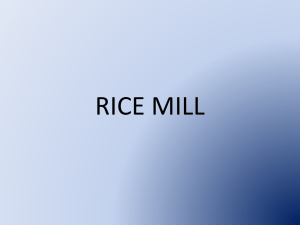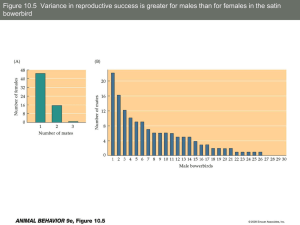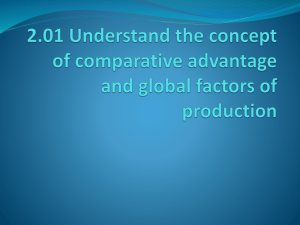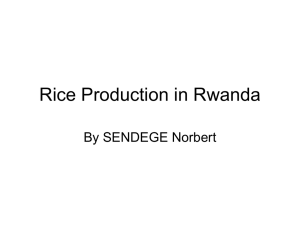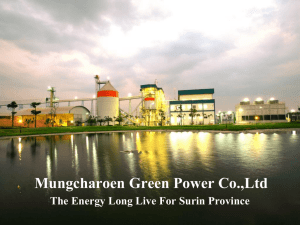PPT - Rice for Africa
advertisement
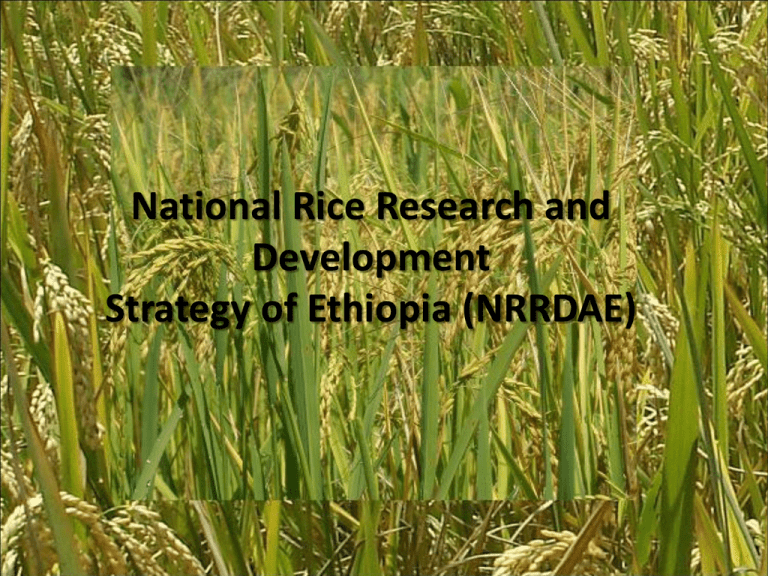
National Rice Research and Development Strategy of Ethiopia (NRRDAE) Introduction: basic facts • The potential rice production area in Ethiopia is estimated to be about seventeen million hectares • It has wider adaptation • The government has also recognized it as a millennium crop in light of ensuring food security in Ethiopia • Rice is important sector along with the focus given to Agriculture in the GoE’s poverty reduction strategy, • the 2004 Food Security Strategy (FSS), • the 2006 Plan for Accelerated and Sustained Development to End Poverty (PASDEP) • the new PASDEP is expected to incorporate the targets of this strategic document. Basic facts: Rice Production Trends • The development aspect in promoting rice production is also limited to certain areas. • However, there is an increasing trend in both area and production of the crop since 2006. 2006 Region Amhara No. of farmers 46,228 Size (ha) 15,392 2007 Production (ton) 34,816 No. of farmers 96,300 Size (ha) 32,100 2008 Production (ton) 73,280 Tigray Benshangual Gumuz Oromiya Somali SNNP Size (ha) Production (ton) 211,440 52,985 140,135 3,600 1,271 3,286 1,474 362 1,181 2,061 683 1,949 8,865 2,955 9,465 22,036 5,875 20,676 150 28 84 13,590 4,530 13,815 5,154 9,920 38,120 4,863 2,424 5,976 31,113 10,371 25,742 15,741 18,721 77,723 657 1314 4,456 260,102 90,448 285,577 Gambella Ethiopia No. of farmers 53,302 18,527 42,825 149,868 49,956 122,302 Rice Suitability Map: Rain-fed Total - about 30 m ha 5.6 m ha highly suitable 25 m ha suitable Rice Suitability Map: irrigation River Basin Irrigable Land (ha) Region (s) Tekeze 83,368 Tigray and Amhara Abbay 815,581 Amhara, Oromiya, Benishangul Gumuz 1,019,523 Benishangul-Gumz, Gambella, Oromia, and SNNPR Baro-Akobbo Omo-Ghibe 67,928 SNNPR and Oromiya Rift Valley (Lakes) 139,300 Oromiya and SNNP Mereb 67,560 Tigray Afar /Denakil 158,776 Afar, Tigray, and Amhara Awash 134,121 Amhara, Oromia, Afar, and Somali Wabi-Shebelle 237,905 Oromia, Harari and Somali Genale-Dawa 1,074,720 Total 3,798,782 Oromia, SNNRP, and Somali regions PRIORITY AREAS AND APPROACHES • Approaches 1) Agro-ecology based promotion of Rice R&D 2) Promotion of both small-scale and commercial rice production 3) Gender consideration 4) Value chain approach promotion 5) Environmentally sustainability Strategies of the NRRDSE • In view of the suggested approaches and addressing the priority areas indentified, the NRRDSE is designed to have nine main strategic components namely i. ii. strengthening the institutional framework and policy development Research, Technology Dissemination, Promotion and Capacity Building; iii. Seed Production, Multiplication and Dissemination of Certified Seed iv. fertilizer marketing and distribution; v. irrigation and investment in water control technologies; vi. pre-harvest technologies, vii. post-harvest technologies viii. access to and maintenance of agricultural machinery and equipment; and ix. access to credit/ agricultural finance. Partnership arrangements i. The NRRDSE will be promoting effective partnership with all stakeholders within the country and also abroad like IRRI, Africa Rice Center, JIRCAS, CARD. ii. The National Rice R&D Steering Committee will take the responsibility in strengthening this partnership. iii. In addition, the Agricultural and Rural Development Partners’ Linkage Advisory Council at federal, regional, zonal and woreda level will play in further strengthening the linkage among stakeholders. Thank you




